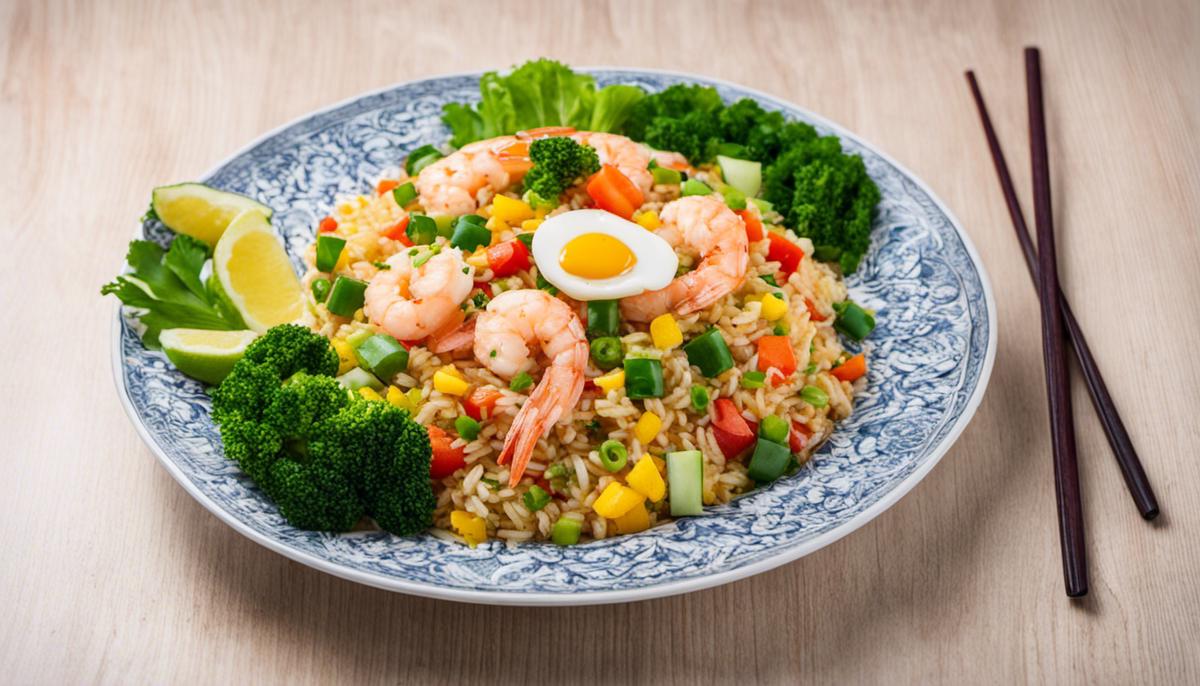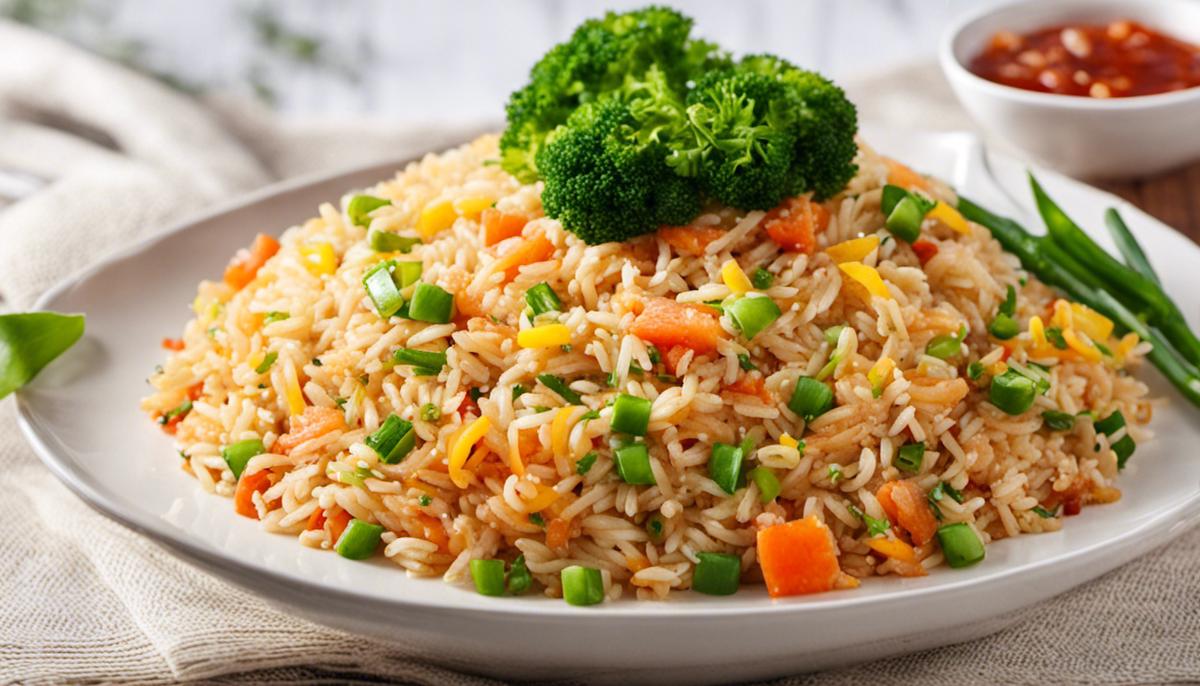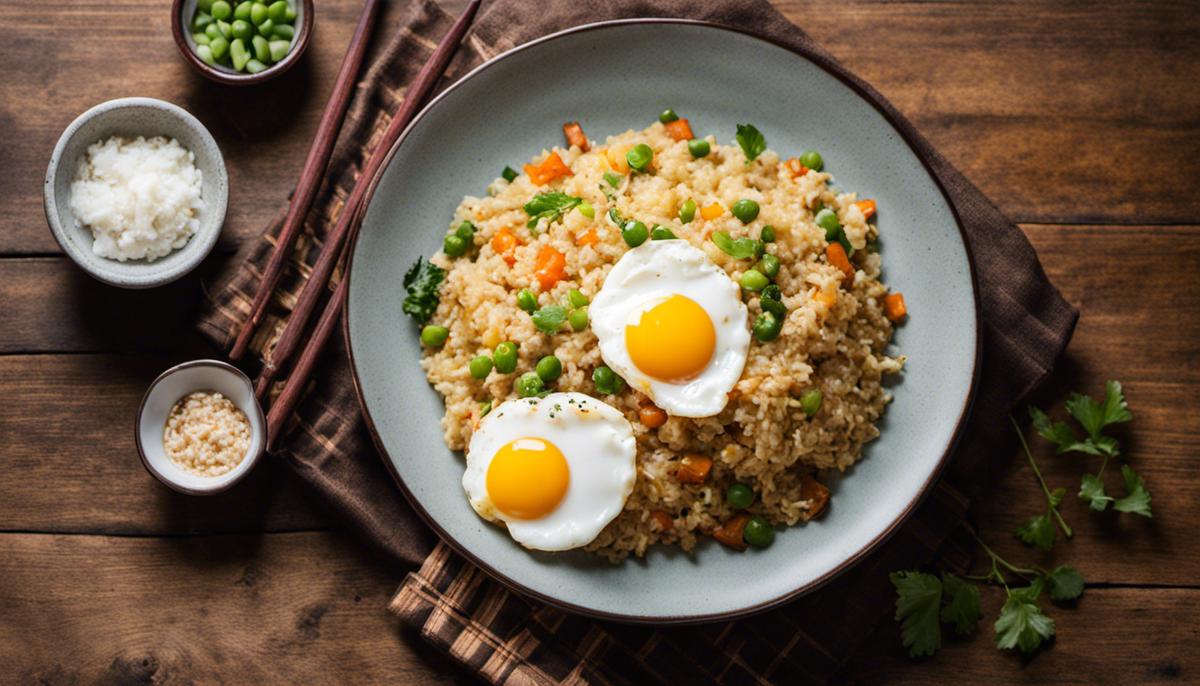If you’ve ever enjoyed a plate of tantalizing fried rice at a restaurant and desired to recreate that magic in your kitchen, then you’re in luck! This insightful piece demystifies the art of preparing simple fried rice. Get ready to embark on a mouth-watering journey as we delve into the crucial aspects of constructing this beloved dish, from grasping the essential ingredients, mastering the rice frying process, and navigating the endless possibilities of fried rice variations to nailing the art of cooking eggs to supplement your plate of fried rice. Let’s stir up some magic in the kitchen!
Understanding the Basic Ingredients
Understanding the Basic Ingredients for Simple Fried Rice
Fried rice is a classic dish that is both delicious and versatile. It’s a fantastic way to make use of leftover ingredients while also adding a tasty side or main dish to your meal. The basic ingredients that are needed for simple fried rice are rice, vegetables, sauteed garlic, optional protein like cooked shrimp or chicken, soy sauce, and eggs.
Rice
Rice is the key ingredient in this dish. Typically, a long grain rice like Jasmine or Basmati is used. It’s important that the rice is cooked and cooled before starting to make fried rice. Leftover rice that has been refrigerated works best because the grains are separate and less likely to stick together.
Vegetables
Vegetables are used to add color, texture, and additional nutrients to the fried rice. Common choices are peas, carrots, and diced onions. These are typically finely chopped and sauteed to soften them before adding to the rice. Using a frozen mix of peas and carrots can also save on preparation time.
Sauteed Garlic
Sauteed garlic adds a deep, savory flavor to the fried rice. You can use fresh minced garlic or garlic paste. It should be lightly sauteed to bring out the aroma before adding the other ingredients.
Optional Protein
If you wish to add protein to your fried rice, cooked shrimp or chicken are great options. Make sure that they are fully cooked before adding to the rice. These can also be swapped out for tofu or kept out entirely for a vegetarian version of the dish.
Soy Sauce
Soy sauce is an important ingredient as it adds color and a rich, salty, umami flavor. It is usually added to the rice towards the end of cooking. Both the regular and low-sodium versions can be used according to your preference.
Eggs
Finally, eggs are scrambled and mixed into the fried rice, adding protein and a distinct flavor. The eggs are usually whisked and scrambled separately, then added to the rice and vegetables. If you’re making a vegetarian version, you may leave out the eggs or substitute them with tofu.
Experiment and Customize
These ingredients make up the basic structure of a simple fried rice recipe. However, feel free to experiment and add other ingredients that suit your taste.

Mastering the Art of Rice Frying
Gathering Your Ingredients
Fried rice is a simple, yet delightful dish that you can master with a little practice. Start by assembling your ingredients. You’ll need cooked, cooled white or brown rice, soy sauce, cooking oil, a small onion, a few cloves of garlic, some protein (like chicken, beef, or shrimp), and your preferred vegetables such as peas, carrots, and bell peppers. Having everything at your disposal makes the process smoother.
Starting with Aromatics
First, you’ll want to heat a tablespoon or two of oil in a large pan or wok. When the oil is hot, add finely chopped garlic and diced onion to the pan. Sauté them until they’re golden brown and aromatic. This forms the base flavor for your fried rice.
Cooking the Protein
Next, you’ll cook your protein. Adding it to the pan with the sautéed garlic and onions allows the flavors to combine. Make sure your protein is cut into bite-sized pieces to ensure even cooking. Keep stirring until your protein is fully cooked through – for chicken this would be until the pieces are no longer pink inside, for shrimp until they’re pink and opaque.
Adding the Vegetables
Once your protein is cooked, you can add your vegetables. If you’re using fresh veggies, be sure they’re cut into small pieces, and that you add them in the order of which takes longest to cook. For example, add firm vegetables like carrots before softer ones like bell peppers. If you’re using frozen mixed vegetables, they can simply be stir-fried until they’re hot and cooked through.
Mixing the Rice In
After your vegetables are cooked, push them to one side of the pan, leaving space to add the rice. Add a little more oil to the pan if necessary, then add your cooked, cooled rice. Toss the rice in the pan, breaking up any clumps and allowing it to absorb the flavors off the pan. Mixing the rice thoroughly with the other ingredients until it’s heated through is key.
Flavoring with Soy Sauce
Finally, sprinkle your fried rice with soy sauce for flavor. Start with a few tablespoons and mix well, then taste and add more if needed. The soy sauce not only adds a savory umami flavor, but also gives the fried rice its characteristic color.
In a nutshell
Mastering the art of frying rice involves sautéing garlic and onions, cooking your protein, adding the vegetables, mixing in the rice, and flavoring it with soy sauce. With a bit of practice, you can tweak the dish to suit your own preferences, adding other ingredients or spices as you wish.

Fried Rice Variations
Classic Fried Rice Recipe
Before diving into variations, it is important to understand the basics of a traditional fried rice dish. Begin by cooking jasmine rice and letting it cool completely. This is essential for achieving the slightly firm, separate grains that make fried rice distinctive. In a hot pan or wok with oil, fry chopped onions until they’re translucent, then add minced garlic. Follow this with diced carrots and peas (either fresh or frozen), stir-frying until they’re cooked. Add the cooled rice to this mixture and gently stir, breaking up any clumps. The final ingredients are soy sauce, sesame oil and scrambled eggs, distributed evenly throughout the rice.
Vegetable Fried Rice
For a vegetarian take, feel free to get creative with the types of vegetables you use. Bell peppers, broccoli, bok choy, and zucchini are all viable options. You can also add tofu instead of eggs for some protein. Tofu will provide a chewy texture contrasting the crunch of the vegetables.
Seafood Fried Rice
For a seafood variation, shrimp, scallops or crab are popular choices—cooked separately and then added into the rice along with the vegetables. You may also replace soy sauce with oyster sauce, providing a deeper, umami flavor.
Hawaiian Fried Rice
The Hawaiian take on fried rice involves pineapples and ham. The tangy sweetness of the pineapple juxtaposes wonderfully with the savory ham, creating an interesting flavor dynamic.
Mexican-style Fried Rice
Mexican fried rice includes traditional Mexican ingredients such as black beans, corn, diced tomatoes, jalapenos, cumin, and lime. Instead of sesame oil and soy sauce, use olive oil to sauté the ingredients and add a few dashes of hot sauce at the end.
Japanese-style Fried Rice: Chahan
Chahan is Japanese-style fried rice typically cooked with soy sauce, oyster sauce, and chicken stock. The proteins in Chahan are typically chicken, shrimp, or pork, and the vegetables often include peas and finely chopped carrots.
Fried Rice Toppings
To add another layer of flavor to your fried rice dish, consider sprinkling on some unusual toppings before serving. Toasted sesame seeds, fresh cilantro, green onions, roasted peanuts, even a sunny-side-up egg can all add a surprising crunch or burst of flavor to each mouthful.
Remember, the beauty of fried rice lies in its flexibility. Feel free to modify the recipes given to suit your own preferences or dietary needs.

Perfecting Eggs for Fried Rice
Understanding the Perfect Egg Consistency for Fried Rice
The key to perfecting eggs for fried rice is achieving the right consistency. While scrambled eggs for breakfast are often creamy and a little runny, those that go best with fried rice should be fully set and lightly browned. Too soggy, and the eggs will make the rice mushy. Too hard, and the eggs will become chewy and unpleasant. To achieve this middle-of-the-road consistency, it’s necessary to cook your eggs until they are fully scrambled but not overcooked.
Choosing the Right Type of Eggs
While any type of eggs can technically work for fried rice, it is preferable to use fresh, large eggs. Older eggs might dry out too much and lose their fluffy texture when fried. Also, larger eggs typically offer more yolk, which offers a richer flavor to the overall dish. Regardless, it’s important to break your eggs into a separate bowl prior to cooking to avoid shell fragments in your dish, check for freshness, and allowing for a smoother cooking process.
Perfect Egg Cooking Technique for Fried Rice
Starting the cooking process with a hot pan is essential. Begin by heating your pan over medium-high heat and add a drizzle of cooking oil once the pan is hot. While it’s heating, beat your eggs in a separate bowl until yolks and whites are fully combined. Once the oil is hot but not smoking, add the beaten eggs to the pan. Let the eggs cook undisturbed for a few seconds until they start to set on the bottom. Then, gently stir them in order to scramble. Continue stirring until the eggs are mostly cooked, but still slightly glossy. Avoid letting them turn brown, which indicates that they’re overcooked and will taste rubbery. Once done, remove the eggs from the pan and set them aside.
Incorporating eggs into Fried Rice
The best time to add the eggs to your fried rice is after you’ve fried the rice and vegetables and right before adding the sauce. This gives the eggs a chance to reheat without becoming rubbery. Once you’ve added the eggs, stir the rice mixture gently to break up the eggs and distribute them evenly throughout the dish. Once the components are all adequately mixed, you’re ready to serve your perfectly egg-ed fried rice.
Remember, practice makes perfect. Technique and timing can take some experimentation to perfect so don’t fret if it doesn’t come out perfect the first time. Keep trying and soon you’ll have delicious, fluffy eggs in your fried rice every time.

The simplicity and adaptability of fried rice make this humble dish truly wonderful. Gaining knowledge about the basics, from key ingredients to traditional frying techniques, paves the way for limitless culinary exploration – a testament to fried rice’s magic and global appeal. As you continue on your culinary journey, remember the value of practice and creativity; soon, you’ll find that not only can you recreate your favorite takeout fried rice, but you’ll also be well on your way to concocting your personalized version. After all, great cooking isn’t just about following recipes – it’s about making your taste buds dance with delight.
